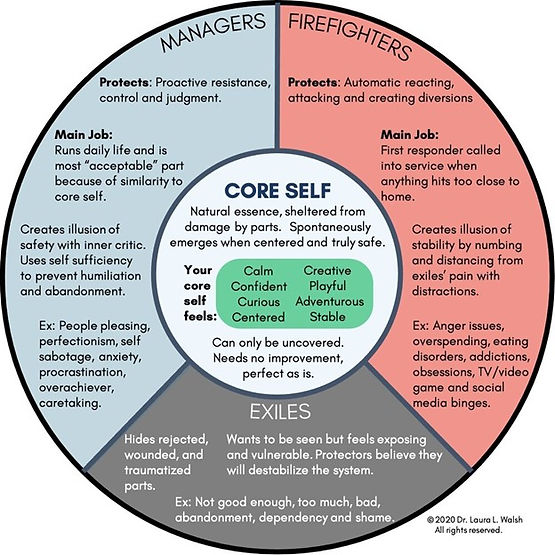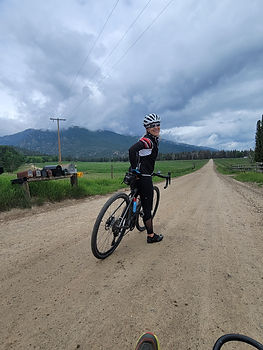Who Am I: How to Use IFS for Understanding Why You Do What You Do (Part 2)
In Part 1 of this series I introduced the concepts of inner diversity and multiplicity as described by the therapeutic model, Internal Family Systems (IFS). We began to integrate the idea that within each of us exists a tapestry of different parts that make us who we are. Today we will take a deeper dive into the different parts, their roles, and how to use IFS to help you understand why you do what you do.
Why Get to Know Your Parts?
Have you ever felt like there are different parts within you, each with its own voice and perspective? Understanding and embracing these parts can lead to greater self-awareness, which has the power to bolster your sense of self-connection, which can enhance your capacity for self-alignment. What does all this really mean? Through this work you can operate with a greater sense of ease, balance, and well-being because your parts are collaborating!
Destructive Behaviors are Signposts
I shared previously that it was destructive behaviors that led me down a path of beginning to embrace and understand my various parts. In my late teens and early 20’s my eating had become significantly disordered, my life closing in on itself. I was isolating, avoiding connection with friends and family, and unable to get hired.
The eating disorder behavior was driven by a part of me that I later came to understand had very good intentions of protecting me from feeling the vulnerable emotions of a deeply wounded part. As I learned to be with the pain of this part, the part that was driving the disordered eating and controlling behaviors could relax.

It wasn’t until I stopped abandoning the difficult and deep emotions of the wounded part that I began to heal, and the control shifted into perspective.
I like to imagine each part operating on a continuum. The more safety and compassion there is in the system, the less extreme our parts need to be.
Big Feelings are Invitations
In a recent session with a client, we were discussing this very idea, that parts, much like the emotions we experience, operate on a continuum from relaxed and open, to extreme and reactive. Curiosity, for example, can feel unbound, gentle, and without an agenda or when in its extreme form, can feel hurried, tight, and urgent.
Have you ever been in a situation with someone where they have a lot of questions, and they’re being lobbed at you hard and fast? It can feel like you’re being interrogated versus listened to and nurtured by a curious presence.
Before I dig in too deeply, let’s take a higher level view to continue laying a foundation.
Facts about Inner Diversity and Parts
- Internal Family Systems (IFS): Developed by Dr. Richard Schwartz, IFS is a therapeutic approach that recognizes the existence of multiple inner parts within each individual.
- Protectors and Exiles: According to IFS, our inner parts can be categorized into two main groups. Protectors aim to shield us from pain and vulnerability, while exiles carry our wounded or vulnerable emotions.
- Role of the Self: The Self, in IFS terminology, represents the core of our being—the wise and compassionate center that can lead and integrate our parts.
- Unburdening and Healing: The goal of IFS is to cultivate a harmonious relationship with our parts, allowing them to unburden their roles and ultimately heal the underlying wounds.

As you can see, inner diversity encompasses the recognition that we are not a singular, monolithic self but rather a complex system of interrelated parts. These parts can range from protective and nurturing aspects, to wounded and vulnerable ones. They may have different roles, perspectives, and needs. When they show up, it can feel as if we’re being pulled in different directions, as they show up often with varied thoughts, emotions, and behaviors.
Our Parts Can Help Us Heal
The concept of inner diversity in IFS emphasizes that each part within us has its own validity and purpose. Instead of pathologizing or suppressing certain parts, IFS encourages a compassionate and non-judgmental approach, acknowledging that all parts are essential and deserving of understanding and acceptance. This approach recognizes that every part has valuable contributions and holds important information that can lead to healing, growth, and integration.
By embracing inner diversity within the IFS framework, we foster an inclusive and respectful internal environment. The aim of this approach is to develop a harmonious relationship among our parts and within the system as a whole. When we practice getting to know our parts, communication, collaboration, and a sense of teamwork can grow. Accessing the wisdom and resources of each part promotes balance, well-being, and a deeper sense of inner connection.
Let’s look a little more closely at the types of parts and their roles. You can view the image below to aid in your understanding.
Types of Parts & Their Roles
Internal Family Systems (IFS) distinguishes between different types of parts, each with its own unique role and function. Here are some of the common parts that can be present:
Exiles
Wounded or vulnerable parts carry unresolved emotional pain, trauma, or unmet needs from past experiences. Exiles often hold memories or emotions that were too overwhelming to process at the time they occurred. Often, they’ll manifest as feelings of sadness, fear, or shame.
Managers
These parts take on the responsibility of protecting us from experiencing pain or reactivating old wounds. They often exhibit controlling, perfectionistic, or proactive behaviors to maintain a sense of safety and control. Managers may push us to achieve, criticize ourselves harshly, or avoid situations that trigger vulnerability.

Firefighters
These parts emerge in response to distress or overwhelming emotions triggered by the exiles. Their role is to distract or numb us from the pain by engaging in impulsive or destructive behaviors. Additionally, firefighters can manifest as addictive tendencies, self-harming behaviors, or escapist activities such as overeating, substance abuse, or excessive work.
Self-Energy
The Self is the core essence or true nature within us. It is the compassionate, wise, and grounded energy that has the capacity to hold and heal other parts. You may recognize its presence when you feel a sense of calmness, curiosity, courage, and clarity. It acts as a unifying force, facilitating harmony, and guiding the internal system towards balance and integration. Some like to imagine the Self as the wise guide.

Your Inner World is Vast
Each person’s internal system is highly individualized, with parts that have their own unique characteristics and roles. Some parts may serve multiple functions or transition between different roles depending on the situation.
Embracing our inner diversity and understanding the role of parts can be a transformative journey. By applying the principles of Internal Family Systems, we prompt many resources. We may cultivate self-compassion, navigate challenges with greater awareness, and foster a deeper sense of integration within ourselves. Each part of us has a valuable story to tell. By embracing them, we can unlock our full potential for growth and self-discovery.

In the previous blog I invited you to just begin to notice the different thoughts that show up in your mind, the emotions you experience, and the sensory information you feel in your body. These are all the ways that the various parts of you might show up.
Now, take a few moments to reflect on the following questions, stepping more fully into this activity. By exploring the vast landscape of your inner world, your parts can help you understand why you do what you do. You might be surprised by the insights and wisdom that emerge.
Reflections
- Can you identify any specific parts within yourself? How do they manifest and influence your thoughts, emotions, and behaviors?
- Are there any parts that you find challenging to accept or understand? How might embracing their perspectives contribute to your overall well-being?
- How can you connect with your Self—the wise and compassionate core—when interacting with your parts? What practices or activities support this connection?
Stay tuned for Part 3 where we’ll continue our exploration of inner diversity and delve deeper into the world of parts. I’ll share with you an analogy that brings to life these concepts! Until then, embrace your unique inner tapestry!
If you have any questions or would like to share your insights, feel free to leave a comment! I would love to hear from you!






